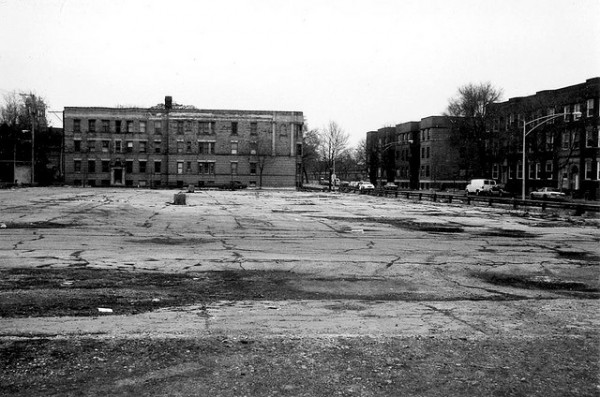Op-Ed: ‘Demolition’ is not a bad word — Just keep it strategic
September 26, 2013


Vacant land in Chicago. Credit: Zachary Korb on Flickr
Cross-posted from Next City, this article is part of the 2013 Reclaiming Vacant Properties Conference liveblog series. Check out all the in-depth content — even if you weren’t able to join us in Philadelphia from September 9-11, 2013, you’ll feel like you did!
Vacant properties and otherwise blighted and deeply undervalued parcels are one of the key challenges of “legacy cities,” or municipalities that have been battling their way back from manufacturing decline and population loss for decades. Prominent in our recommendations in the report “Regenerating America’s Legacy Cities,” an analysis of 18 struggling cities published by the Lincoln Institute of Land Policy, is the notion that cities should not be afraid to demolish.
Repurposing large inventories of vacant land strategically is a major springboard for change in heavily disinvested areas. Cities should explore large-scale reconfiguration of land uses (see what’s happening in Baltimore), including the use of vacant properties for public open space, urban agriculture or stormwater management. But demolition has to be strategic, not piecemeal or driven by the “squeaky wheel” principle.
This measured approach to vacant properties is part of an overall strategy we have labeled “strategic incrementalism.” It means forgoing silver bullets such as building casinos, sports stadiums or convention centers, but fostering regeneration in a way that looks more like silver buckshot: Taking stock and moving block by block to build on the assets that all legacy cities have. Other key components include:
- Making the most of downtowns. The physical fabric of the central core, with a dense, walkable texture and proximity to major institutions and employers, is a powerful attraction for young single people and couples, and a strong basis for residential redevelopment. Set a friendly regulatory environment for infill redevelopment, reinvent public spaces and encourage private market reuse of older buildings.
- Sustaining viable neighborhoods. In these targeted areas, build partnerships with neighborhood associations and CDCs to implement multifaceted neighborhood strategies that draw demand, rebuild housing markets and address destabilizing elements such as crime, foreclosure, and property abandonment.
- Reinventing the economic base. Not every city can become the next biotech capital. But an honest assessment of local assets and regional competitive advantages can help cities identify the potential for and build new export-oriented economies. Partner with local educational institutions and major employers to build an educational and workforce development and a competitive regional labor market.
- Building new partnerships. In almost every city, universities and medical centers — “eds and meds” – are bedrock institutions, part of a foundational network of public, non-profit and private collaboration. In Camden, N.J., a legacy city on the brink for decades, Cooper University Hospital, the city’s largest employer, is expanding and investing. Similarly, state and federal governments must rethink their roles, becoming more nimble, more effective, less biased towards suburban areas and more supportive of homegrown regeneration initiatives. The Obama administration’s Sustainable Communities initiative is a good start.
- Making sure all city residents benefit from change. Many cities are fractured, with large and growing spatial, economic and racial disparities. Engaging residents, and providing the educational and workforce development systems to enable currently marginalized populations to become competitive, can build a stronger city for everyone.
If there’s one common theme that has emerged from our analysis, it’s that strong regions are a distinguishing feature of thriving cities around the world. While legacy cities and their regions are already inextricably linked by social and economic realities, far more must be done to make these connections positive forces for regeneration both in the city and the rest of the region. Public policy changes at both state and national levels should be pursued to foster greater regional integration. Regionalized infrastructure systems, particularly transit, sewer and water systems, should be encouraged to strengthen city and regional ties that foster economic growth.
The more measured, case-by-case approach may be less likely to grab headlines than sweeping plans, but the daunting obstacles to change can be overcome through a process of gradual, incremental actions driven by a shared vision. Rather than devote significant time and resources to large-scale comprehensive planning, legacy cities should focus on building partnerships, supporting multiple initiatives and building broad-based, organic support for a shared vision for the future.
Alan Mallach and Lavea Brachman are the authors of “Regenerating America’s Legacy Cities,” a report from the Lincoln Institute of Land Policy.
Recent Posts
Subscribe to join 14,000 community development leaders getting the latest resources from top experts on vacant property revitalization.
